JEEP RENEGADE 2014 1.G Owners Manual
Manufacturer: JEEP, Model Year: 2014, Model line: RENEGADE, Model: JEEP RENEGADE 2014 1.GPages: 212, PDF Size: 17.48 MB
Page 171 of 212
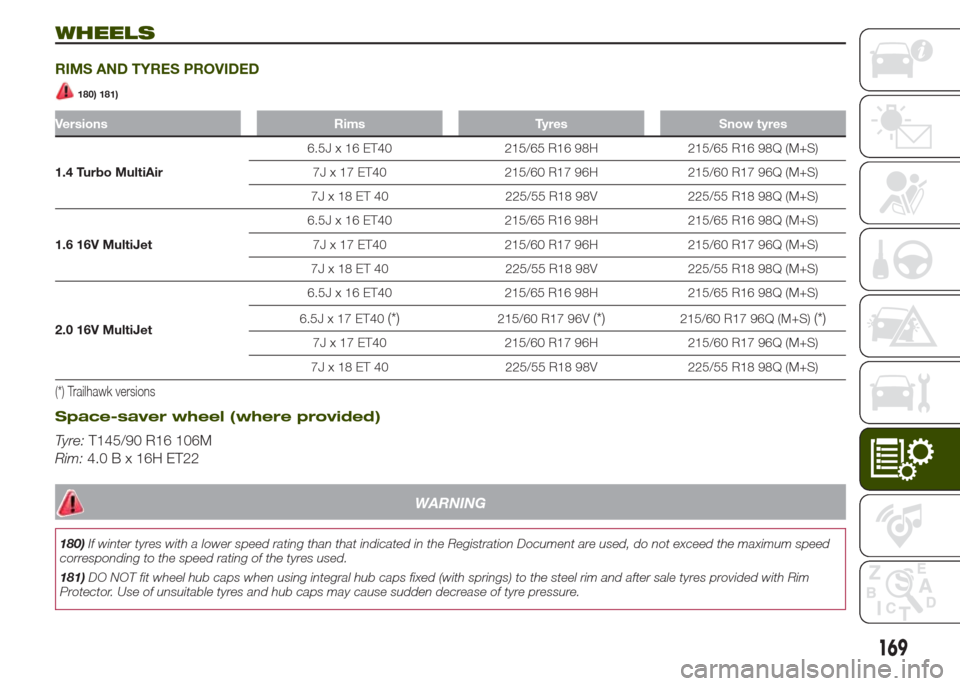
WHEELS
RIMS AND TYRES PROVIDED
180) 181)
Versions Rims Tyres Snow tyres
1.4 Turbo MultiAir6.5J x 16 ET40 215/65 R16 98H 215/65 R16 98Q (M+S)
7J x 17 ET40 215/60 R17 96H 215/60 R17 96Q (M+S)
7J x 18 ET 40 225/55 R18 98V 225/55 R18 98Q (M+S)
1.6 16V MultiJet6.5J x 16 ET40 215/65 R16 98H 215/65 R16 98Q (M+S)
7J x 17 ET40 215/60 R17 96H 215/60 R17 96Q (M+S)
7J x 18 ET 40 225/55 R18 98V 225/55 R18 98Q (M+S)
2.0 16V MultiJet6.5J x 16 ET40 215/65 R16 98H 215/65 R16 98Q (M+S)
6.5J x 17 ET40
(*)215/60 R17 96V(*)215/60 R17 96Q (M+S)(*)
7J x 17 ET40 215/60 R17 96H 215/60 R17 96Q (M+S)
7J x 18 ET 40 225/55 R18 98V 225/55 R18 98Q (M+S)
(*) Trailhawk versions
Space-saver wheel (where provided)
Tyre:T145/90 R16 106M
Rim:4.0 B x 16H ET22
WARNING
180)If winter tyres with a lower speed rating than that indicated in the Registration Document are used, do not exceed the maximum speed
corresponding to the speed rating of the tyres used.
181)DO NOT fit wheel hub caps when using integral hub caps fixed (with springs) to the steel rim and after sale tyres provided with Rim
Protector. Use of unsuitable tyres and hub caps may cause sudden decrease of tyre pressure.
169
Page 172 of 212
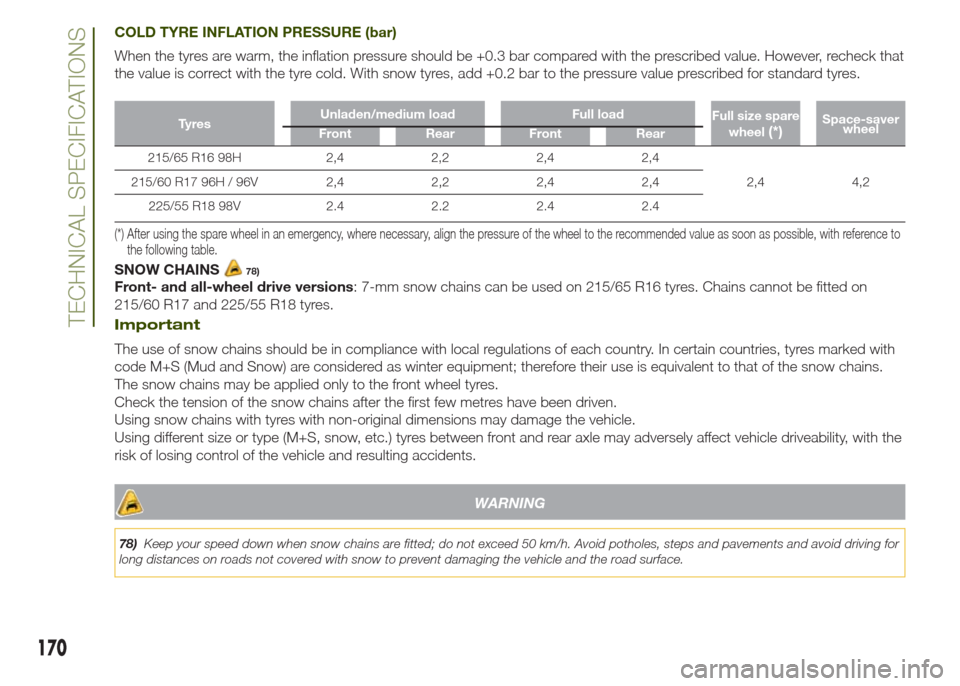
COLD TYRE INFLATION PRESSURE (bar)
When the tyres are warm, the inflation pressure should be +0.3 bar compared with the prescribed value. However, recheck that
the value is correct with the tyre cold. With snow tyres, add +0.2 bar to the pressure value prescribed for standard tyres.
Ty r e sUnladen/medium load Full load
Full size spare
wheel(*)Space-saver
wheel
Front Rear Front Rear
215/65 R16 98H 2,4 2,2 2,4 2,4
2,4 4,2 215/60 R17 96H / 96V 2,4 2,2 2,4 2,4
225/55 R18 98V 2.4 2.2 2.4 2.4
(*) After using the spare wheel in an emergency, where necessary, align the pressure of the wheel to the recommended value as soon as possible, with reference to
the following table.
SNOW CHAINS78)
Front- and all-wheel drive versions: 7-mm snow chains can be used on 215/65 R16 tyres. Chains cannot be fitted on
215/60 R17 and 225/55 R18 tyres.
Important
The use of snow chains should be in compliance with local regulations of each country. In certain countries, tyres marked with
code M+S (Mud and Snow) are considered as winter equipment; therefore their use is equivalent to that of the snow chains.
The snow chains may be applied only to the front wheel tyres.
Check the tension of the snow chains after the first few metres have been driven.
Using snow chains with tyres with non-original dimensions may damage the vehicle.
Using different size or type (M+S, snow, etc.) tyres between front and rear axle may adversely affect vehicle driveability, with the
risk of losing control of the vehicle and resulting accidents.
WARNING
78)Keep your speed down when snow chains are fitted; do not exceed 50 km/h. Avoid potholes, steps and pavements and avoid driving for
long distances on roads not covered with snow to prevent damaging the vehicle and the road surface.
170
TECHNICAL SPECIFICATIONS
Page 173 of 212
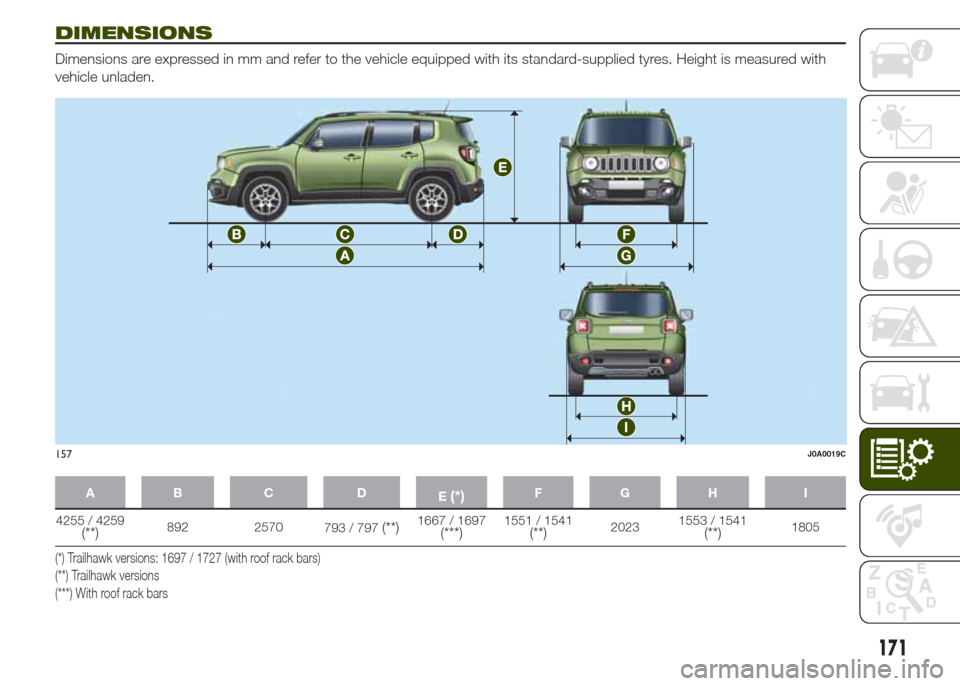
DIMENSIONS
Dimensions are expressed in mm and refer to the vehicle equipped with its standard-supplied tyres. Height is measured with
vehicle unladen.
AB C D
E(*)FGH I
4255 / 4259(**)892 2570
793 / 797(**)1667 / 1697(***)1551 / 1541(**)20231553 / 1541(**)1805
(*) Trailhawk versions: 1697 / 1727 (with roof rack bars)
(**) Trailhawk versions
(***) With roof rack bars
157J0A0019C
171
Page 174 of 212
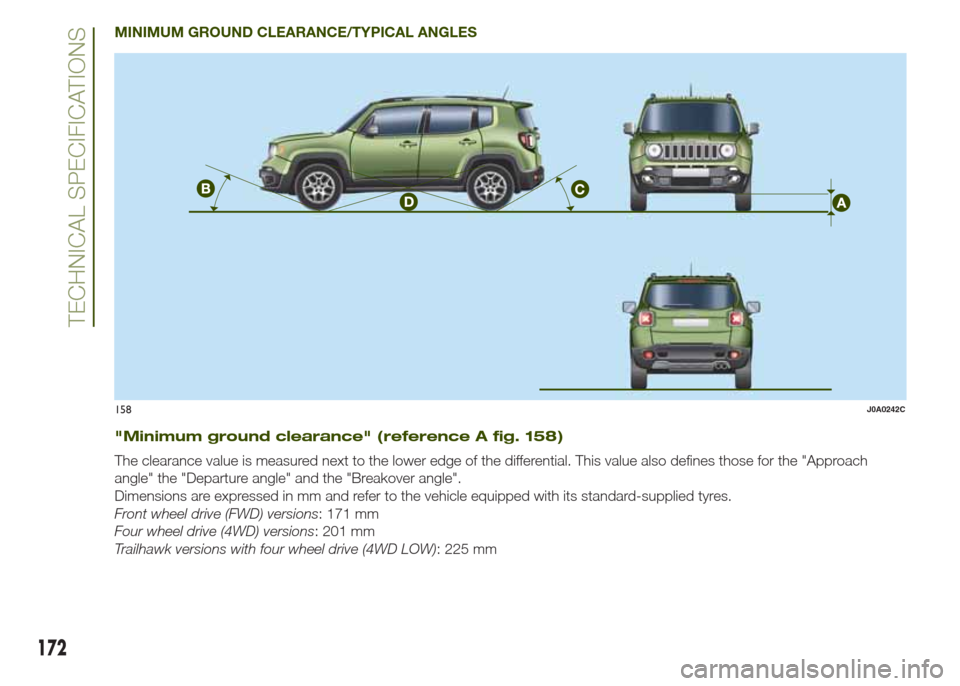
MINIMUM GROUND CLEARANCE/TYPICAL ANGLES
"Minimum ground clearance" (reference A fig. 158)
The clearance value is measured next to the lower edge of the differential. This value also defines those for the "Approach
angle" the "Departure angle" and the "Breakover angle".
Dimensions are expressed in mm and refer to the vehicle equipped with its standard-supplied tyres.
Front wheel drive (FWD) versions: 171 mm
Four wheel drive (4WD) versions: 201 mm
Trailhawk versions with four wheel drive (4WD LOW): 225 mm
158J0A0242C
172
TECHNICAL SPECIFICATIONS
Page 175 of 212
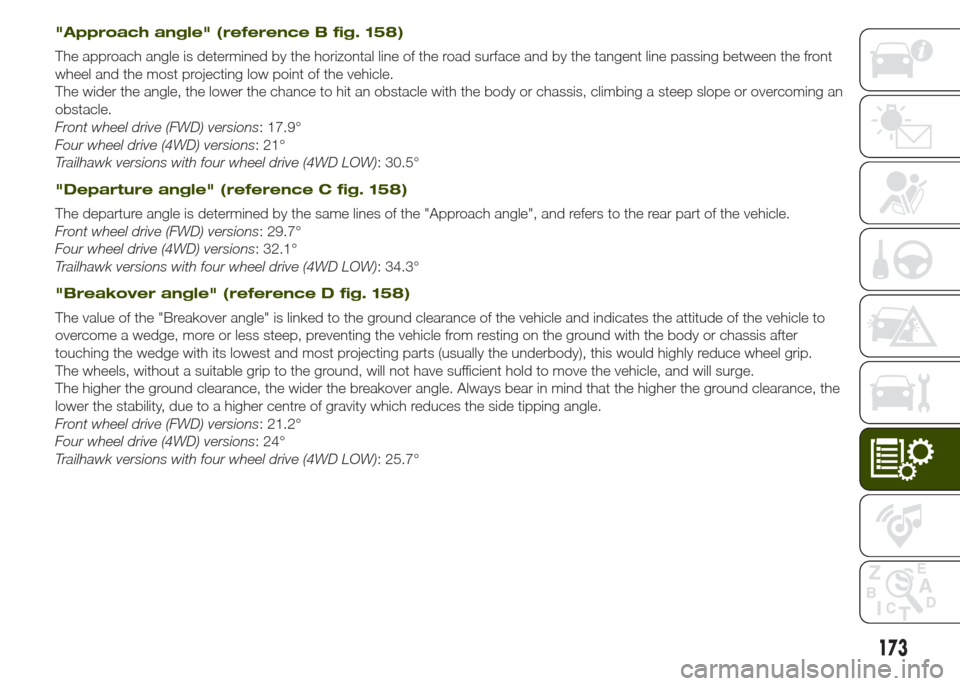
"Approach angle" (reference B fig. 158)
The approach angle is determined by the horizontal line of the road surface and by the tangent line passing between the front
wheel and the most projecting low point of the vehicle.
The wider the angle, the lower the chance to hit an obstacle with the body or chassis, climbing a steep slope or overcoming an
obstacle.
Front wheel drive (FWD) versions: 17.9°
Four wheel drive (4WD) versions: 21°
Trailhawk versions with four wheel drive (4WD LOW): 30.5°
"Departure angle" (reference C fig. 158)
The departure angle is determined by the same lines of the "Approach angle", and refers to the rear part of the vehicle.
Front wheel drive (FWD) versions: 29.7°
Four wheel drive (4WD) versions: 32.1°
Trailhawk versions with four wheel drive (4WD LOW): 34.3°
"Breakover angle" (reference D fig. 158)
The value of the "Breakover angle" is linked to the ground clearance of the vehicle and indicates the attitude of the vehicle to
overcome a wedge, more or less steep, preventing the vehicle from resting on the ground with the body or chassis after
touching the wedge with its lowest and most projecting parts (usually the underbody), this would highly reduce wheel grip.
The wheels, without a suitable grip to the ground, will not have sufficient hold to move the vehicle, and will surge.
The higher the ground clearance, the wider the breakover angle. Always bear in mind that the higher the ground clearance, the
lower the stability, due to a higher centre of gravity which reduces the side tipping angle.
Front wheel drive (FWD) versions: 21.2°
Four wheel drive (4WD) versions: 24°
Trailhawk versions with four wheel drive (4WD LOW): 25.7°
173
Page 176 of 212
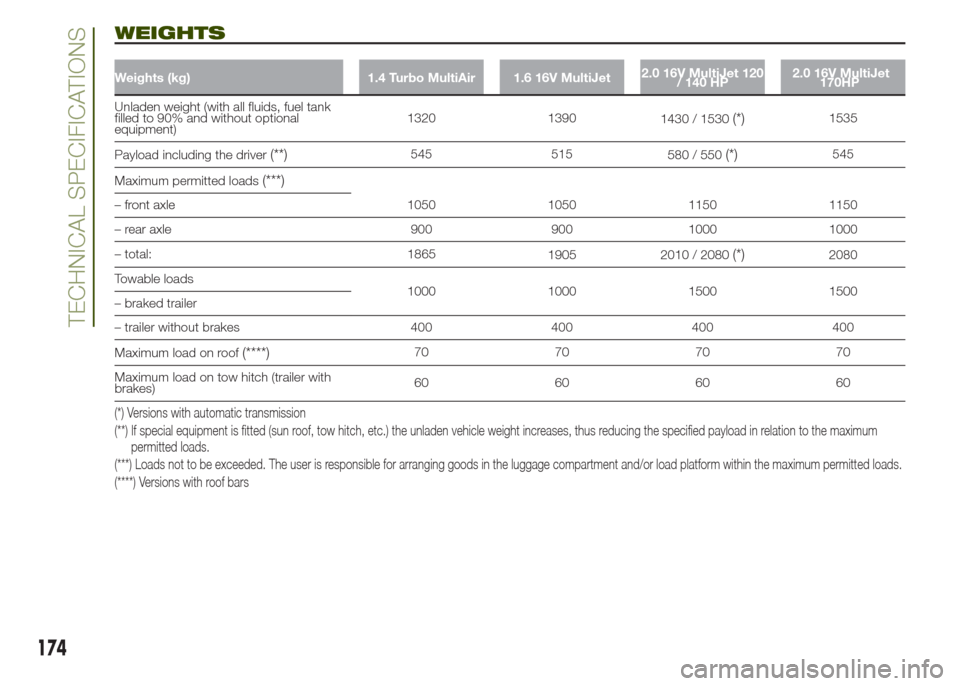
WEIGHTS
Weights (kg) 1.4 Turbo MultiAir 1.6 16V MultiJet 2.0 16V MultiJet 120 / 140 HP 2.0 16V MultiJet
Unladen weight (with all fluids, fuel tank filled to 90% and without optional equipment) 1320 1390 1430 / 1530(*)1535
Payload including the driver(**)545 515 580 / 550(*)545
Maximum permitted loads(***)
1050 1050 1150 1150 – front axle
– rear axle 900 900 1000 1000
– total: 1865 1905 2010 / 2080(*)2080
Towable loads 1000 1000 1500 1500 – braked trailer
– trailer without brakes 400 400 400 400
Maximum load on roof(****)70 70 70 70
Maximum load on tow hitch (trailer with brakes) 60 60 60 60
(*) Versions with automatic transmission
(**) If special equipment is fitted (sun roof, tow hitch, etc.) the unladen vehicle weight increases, thus reducing the specified payload in relation to the maximum permitted loads.
(***) Loads not to be exceeded. The user is responsible for arranging goods in the luggage compartment and/or load platform within the maximum permitt ed loads.
(****) Versions with roof bars
174
TECHNICAL SPECIFICATIONS
170HP
Page 177 of 212

SUPPLIES
1.4 Turbo MultiAir 1.6 16V MultiJet 2.0 16V MultiJet
Fuel tank (litres): 48 48 48
including a reserve of (litres): 5 ÷ 7 5 ÷ 7 5 ÷ 7
Engine cooling system (litres): 5.2 6.1 6.5
Engine sump (litres): 4.1 4.4 3.9
Engine sump and filter (litres): 4.5 4.8 4.3
Gearbox/differential casing
(litres):1.8 1.8
1.8
(*)/ 6.0(**)
Idler unit (PTU) (litres): – – 0.4
Rear differential (litres): – – 0.6
Hydraulic brake circuit (kg): 0.83 0,83 0.83
Windscreen and rear window
washer fluid reservoir (litres):2.5 2.5 2.5
(*) Versions with manual gearbox
(**) Versions with automatic transmission
175
Page 178 of 212
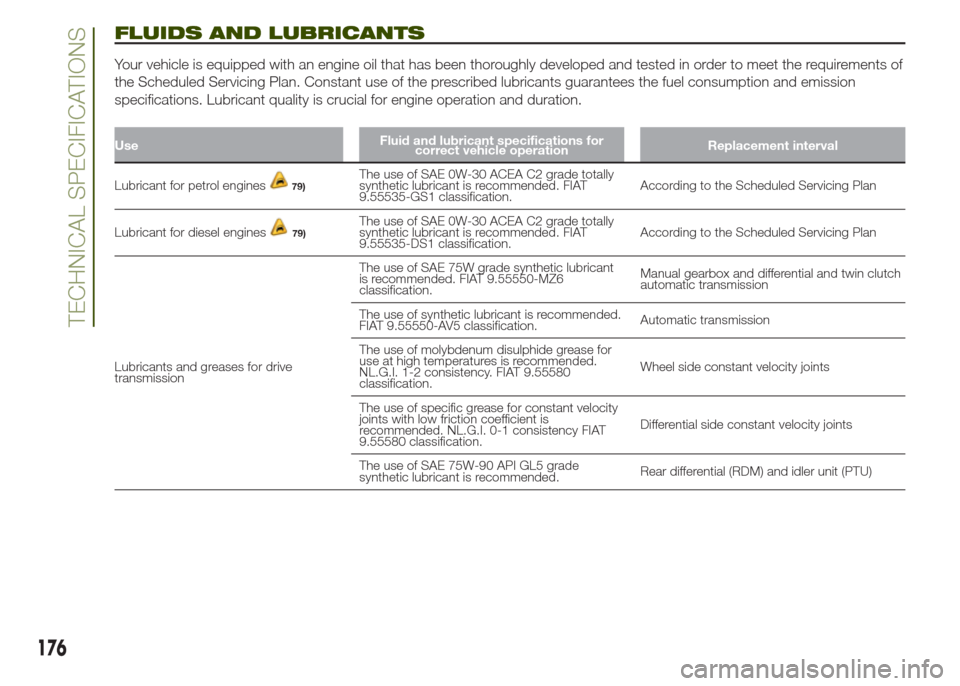
FLUIDS AND LUBRICANTS
Your vehicle is equipped with an engine oil that has been thoroughly developed and tested in order to meet the requirements of
the Scheduled Servicing Plan. Constant use of the prescribed lubricants guarantees the fuel consumption and emission
specifications. Lubricant quality is crucial for engine operation and duration.
UseFluid and lubricant specifications for
correct vehicle operationReplacement interval
Lubricant for petrol engines79)The use of SAE 0W-30 ACEA C2 grade totally
synthetic lubricant is recommended. FIAT
9.55535-GS1 classification.According to the Scheduled Servicing Plan
Lubricant for diesel engines
79)The use of SAE 0W-30 ACEA C2 grade totally
synthetic lubricant is recommended. FIAT
9.55535-DS1 classification.According to the Scheduled Servicing Plan
Lubricants and greases for drive
transmissionThe use of SAE 75W grade synthetic lubricant
is recommended. FIAT 9.55550-MZ6
classification.Manual gearbox and differential and twin clutch
automatic transmission
The use of synthetic lubricant is recommended.
FIAT 9.55550-AV5 classification.Automatic transmission
The use of molybdenum disulphide grease for
use at high temperatures is recommended.
NL.G.I. 1-2 consistency. FIAT 9.55580
classification.Wheel side constant velocity joints
The use of specific grease for constant velocity
joints with low friction coefficient is
recommended. NL.G.I. 0-1 consistency FIAT
9.55580 classification.Differential side constant velocity joints
The use of SAE 75W-90 API GL5 grade
synthetic lubricant is recommended.Rear differential (RDM) and idler unit (PTU)
176
TECHNICAL SPECIFICATIONS
Page 179 of 212
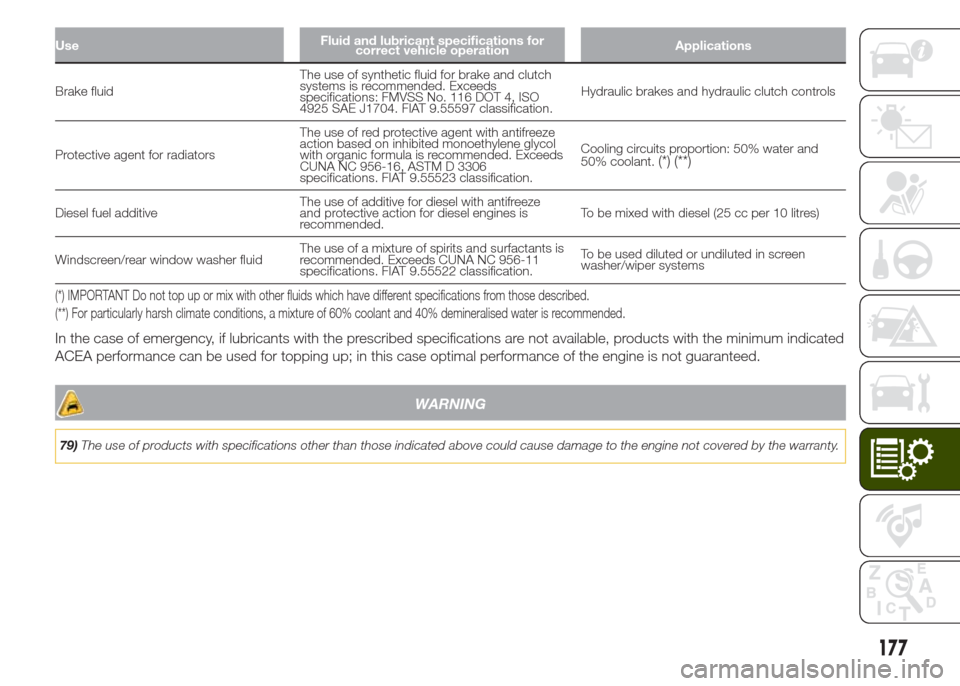
UseFluid and lubricant specifications for
correct vehicle operationApplications
Brake fluidThe use of synthetic fluid for brake and clutch
systems is recommended. Exceeds
specifications: FMVSS No. 116 DOT 4, ISO
4925 SAE J1704. FIAT 9.55597 classification.Hydraulic brakes and hydraulic clutch controls
Protective agent for radiatorsThe use of red protective agent with antifreeze
action based on inhibited monoethylene glycol
with organic formula is recommended. Exceeds
CUNA NC 956-16, ASTM D 3306
specifications. FIAT 9.55523 classification.Cooling circuits proportion: 50% water and
50% coolant.
(*) (**)
Diesel fuel additiveThe use of additive for diesel with antifreeze
and protective action for diesel engines is
recommended.To be mixed with diesel (25 cc per 10 litres)
Windscreen/rear window washer fluidThe use of a mixture of spirits and surfactants is
recommended. Exceeds CUNA NC 956-11
specifications. FIAT 9.55522 classification.To be used diluted or undiluted in screen
washer/wiper systems
(*) IMPORTANT Do not top up or mix with other fluids which have different specifications from those described.
(**) For particularly harsh climate conditions, a mixture of 60% coolant and 40% demineralised water is recommended.
In the case of emergency, if lubricants with the prescribed specifications are not available, products with the minimum indicated
ACEA performance can be used for topping up; in this case optimal performance of the engine is not guaranteed.
WARNING
79)The use of products with specifications other than those indicated above could cause damage to the engine not covered by the warranty.
177
Page 180 of 212
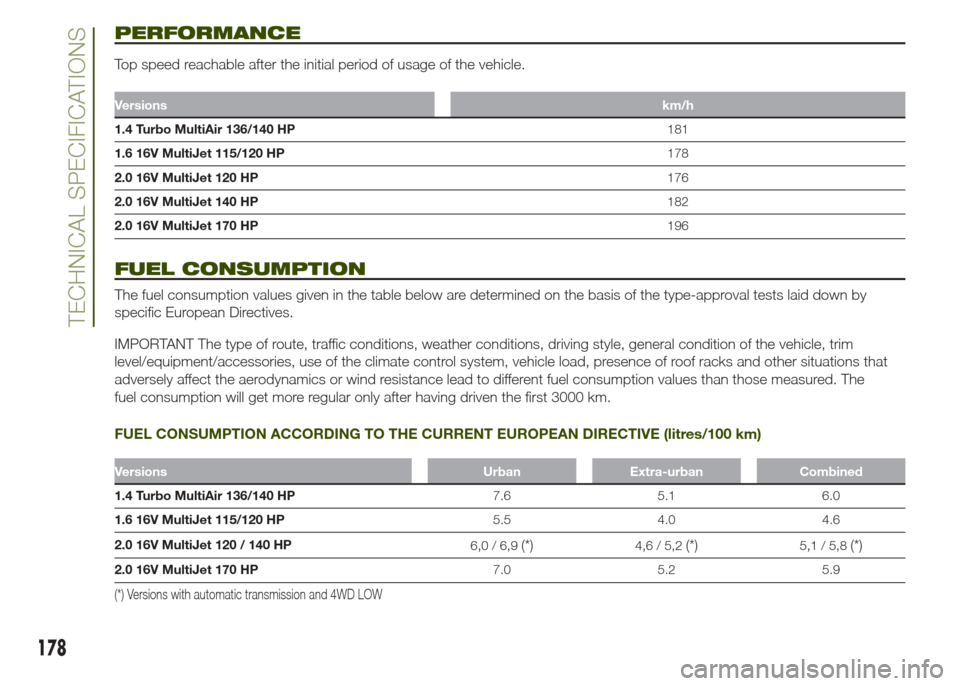
PERFORMANCE
Top speed reachable after the initial period of usage of the vehicle.
Versionskm/h
1.4 Turbo MultiAir 136/140 HP181
1.6 16V MultiJet 115/120 HP178
2.0 16V MultiJet 120 HP176
2.0 16V MultiJet 140 HP182
2.0 16V MultiJet 170 HP196
FUEL CONSUMPTION
The fuel consumption values given in the table below are determined on the basis of the type-approval tests laid down by
specific European Directives.
IMPORTANT The type of route, traffic conditions, weather conditions, driving style, general condition of the vehicle, trim
level/equipment/accessories, use of the climate control system, vehicle load, presence of roof racks and other situations that
adversely affect the aerodynamics or wind resistance lead to different fuel consumption values than those measured. The
fuel consumption will get more regular only after having driven the first 3000 km.
FUEL CONSUMPTION ACCORDING TO THE CURRENT EUROPEAN DIRECTIVE (litres/100 km)
Versions Urban Extra-urban Combined
1.4 Turbo MultiAir 136/140 HP7.6 5.1 6.0
1.6 16V MultiJet 115/120 HP5.5 4.0 4.6
2.0 16V MultiJet 120 / 140 HP
6,0 / 6,9
(*)4,6 / 5,2(*)5,1 / 5,8(*)
2.0 16V MultiJet 170 HP7.0 5.2 5.9
(*) Versions with automatic transmission and 4WD LOW
178
TECHNICAL SPECIFICATIONS